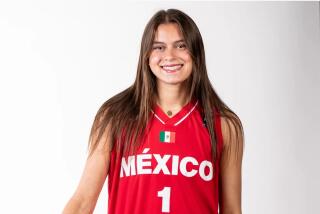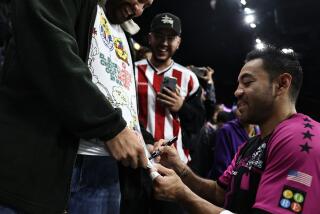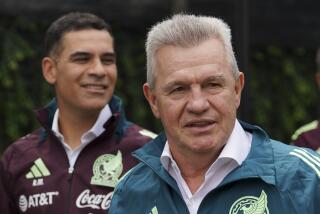WORLD CUP USA ’94 : COMMENTARY : Play of Mexico’s Caped Crusaders Leaves Nation Bullish
- Share via
No matter how many times you have seen the entrance of the bullfighters, it is always a thrilling experience. They come out not in single file, for that would denigrate the fellow in last position, but side by side, as if all were equal, which is the case as the fight begins.
--MEXICO
James Michener
So it will be Tuesday, in the late afternoon shadows of an American football stadium in New Jersey, when the current matadors of Mexico enter side by side, as if they were equal, which will be the case as the fight begins.
Their names are Luis Garcia and Jorge Campos, and unlike the fictional Victoriano Leal and Juan Gomez of Michener’s 1960s Mexico, their opponent will not be life-threatening nor possessed of razor-sharp horns.
But in the World Cup soccer game that Garcia and Campos will play against Bulgaria, there will be many of the same elements of cultural passion that Michener threads through his story of two bullfighters. The people and the plot are fiction, the essence of the place, Mexico, is not.
From well before the start of this monthlong World Cup, to its present point in the round of 16, the path of Mexico’s soccer team has been an emotional roller coaster. That’s not just for the team, but for its country, which, as much or more than any soccer-mad place, ebbs and flows with its football failure and success.
On June 4, Mexico came to the Rose Bowl to play the U.S. national team in what is known in soccer as a friendly. That means the match doesn’t matter in any sort of official qualifying, but is listed in the win-loss columns of the team record.
But this one mattered greatly, no matter how it was labeled.
A crowd of 91,123 turned out, and while that was the largest gathering ever to see the U.S. team play on U.S. soil, the crowd was clearly there to see the team the United States was playing. The Arroyo was a sea of green, orange and white; the colors of the Mexican flag, and the flag itself, dominated the scene like few things other than the Wisconsin Badgers’ avalanche of red six months earlier.
With two weeks to the World Cup opener, it was a dress rehearsal for Mexico. It was the last full-makeup run-through before its return to the international soccer scene after an embarrassing eight-year absence caused by a disqualification from the 1990 World Cup. The Mexican Soccer Federation had sent a team to a junior tournament, and some of the team members weren’t all that junior. The Mexicans had lied about some of the players’ ages, and FIFA, the same international sanctioning group that fines coaches thousands of dollars for harmless arguments with referees and suspends players from entire games for not standing properly in line for free kicks, booted Mexico from the 1990 World Cup.
No matter that Mexico was the soccer power of this section of the world. No matter that Mexico had hosted the World Cup in Mexico City just four years earlier, and had run a generally successful event for FIFA after Colombia had backed out. With FIFA, history has made things like that clear: March at high noon with them and they will always draw first and step easily over the fallen body.
So it had been a long road back to June 4 in the Rose Bowl, and one of the bumps along the way had been the replacement as coach of popular Luis Menotti with Miguel Mejia Baron. Baron was a former dentist and a protege of U.S. Coach Bora Milutinovic, Mexico’s coach in the ’86 Cup.
The day was hot, the fans were torrid and the Mexican team was awful in a 1-0 loss. Losing in soccer is one thing, even in a friendly. But losing to a country that has demonstrated success with its feet only on “American Bandstand” was reason for shame. The Mexican flags and their carriers slinked off into the sunset, unhappy and fearful of the important days ahead.
On June 19, the third day of the tournament, Mexico played Norway in its first of three games in the Group E draw that had quickly, upon its creation at the World Cup soccer draw in late December in Las Vegas, taken on the nickname “Group of Death.” Besides Mexico and Norway, the group included soccer power Italy and darkhorse Ireland.
When the draw took place, Mexico had expected--some said been assured--that it would end up in a group headquartered in Dallas. That would put it very close to a huge friendly fan base.
When the Mexicans heard they were in a group with Ireland and Italy, and would play their games along an Eastern seaboard much more heavily populated with Irish and Italian fans, their soccer contingent marched out of the Las Vegas Convention Center, site of the draw, in a huff.
Six months later, after their 1-0 embarrassment in the Rose Bowl, they marched out again in a huff, exiting the Rose Bowl through a back door with nary a word to the press.
So it was a team in a sulk that played Norway June 19, and lost, 1-0. Aging star Hugo Sanchez, one of only two Mexicans playing in Europe in the prestigious Spanish League, hadn’t played against the United States on June 4, but faced Norway. Just weeks short of his 36th birthday, Sanchez looked slow and ineffective. The second-guessing of Mejia Baron was in full bloom.
But the resilient Mexican fans arrived in force in Orlando June 24 for the second game in the group, truly a death struggle with Ireland.
On one of the many planes in, a stockbroker from Monterrey who had made his connection in Dallas, fretted and tried to think positive.
“I do not think we will win, but I want us so much to, because soccer means so much to my country,” said the stockbroker, Mauricio Calderon. “My father planned this trip for so long, so we come, even after Norway.”
At the game, there were fewer Mexican flags than in the Rose Bowl on June 4, but thousands of shirts and hats that read: “Confia en Mexico.” Believe in Mexico. Have faith in Mexico, in our team.
It was almost a plaintive plea.
Then, in the 44th minute against Ireland, it happened and it all seemed to turn around from that moment.
Garcia, 11 years younger than Sanchez and the other Mexicans playing in the big leagues in Spain, was moved to the right side forward position, from his normal center striker spot. Sanchez was on the bench. Carlos Hermosillo, who hadn’t played against Norway at all, shoveled a neat little pass just outside the penalty box and dead center to the goal. Garcia struck like a striker should, lashing the ball past veteran Irish goalkeeper Pat Bonner.
Mexico had gone from June 4 until the waning moments of the first half of the Ireland game 20 days later--probably close to 240 minutes of playing time including injury time--with nary a goal. When they piled on Garcia in celebration, you could almost feel an entire country breathe a sigh of relief.
Garcia scored again in the second half, Mexico had a 2-1 lead and all the healing that a World Cup victory would bring was close at hand. But then Andy Townsend, Ireland’s sandy-haired captain and midfielder, got an opening just outside the box and to the left of goal in the 81st minute. He sent a screaming, dipping shot that had a real chance until goalkeeper Campos darted left and directed the ball wide of the net. The 2-1 victory was preserved.
That night, the fans went to Church Street Station in Orlando and celebrated well into the morning hours. Suddenly, there were more flags again and fewer of the “Confia en Mexico” hats and shirts. They believed again. They had lived another day in the Group of Death. Garcia and Campos had taken red capes and swords and subdued the enemy.
Last Monday, the day before Mexico was to play Italy in Washington, D.C. in its last game of group play, a youngster headed for the metal detector in the Orlando airport. He was perhaps 10 years old, and he wore a sombrero with a huge rim. As he stepped through the metal detector, the hat was brushed off. He tried once, twice, then a third time. The sombrero was just too wide. Undeterred, he tried a fourth time, tilting his head just enough and slipping through. His family, laughing as they watched, saluted his final success in bullfighting terms: “Ole! Ole! Pedro.”
Against Italy, Garcia and Campos, now clearly the team’s matadors, played beautifully, but Italy scored first. With Ireland and Norway playing simultaneously in Giants Stadium and heading for a 0-0 tie that would leave each with four points in the final group standings, a loss by Mexico would leave it with three points and Italy with six, meaning Mexico would be out.
But the Mexican fans were there in full force, believing in Mexico. As their team’s short passing game got clicking, they greeted each movement with a rhythmic “Ole! Ole! Ole!” And suddenly Marcelino Bernal connected with a 25-yard shot that not only brought the eventual 1-1 tie, but placed Mexico atop Group E’s final standings. No death there, after all.
Tuesday, Mexico can make history. Never before has a Mexican soccer team advanced to the quarterfinals outside of the World Cups held in its country in 1970 and 1986. The leaders, of course, will be Garcia and Campos, legends now from Cancun to Guadalajara.
In Michener’s book, Victoriano Leal is the Spaniard, the finesse bullfighter with grace and careful style and the lighter complexion of his Basque roots; Juan Gomez is the Mexican Indian through and through, a rough-skinned rogue with strength and power and a thirst for the thrill and danger of living on the edge.
Luis Garcia mirrors Michener’s Leal, Jorge Campos mirrors Michener’s Gomez. Whether the fight is with bulls or Bulgarians, Mexico worships its warriors.
Tuesday, in Giants Stadium in the Meadowlands of New Jersey, Garcia and Gomez will enter, side by side, as equals, the Spaniard and the Mexican Indian, their country’s soccer matadors as the fight begins.
Ole! Mexico.








